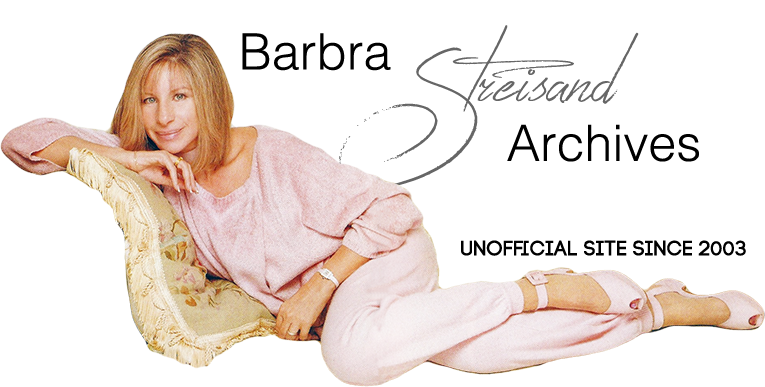Architectural Digest
May 1978
Volume Thirty-Five/Number Four
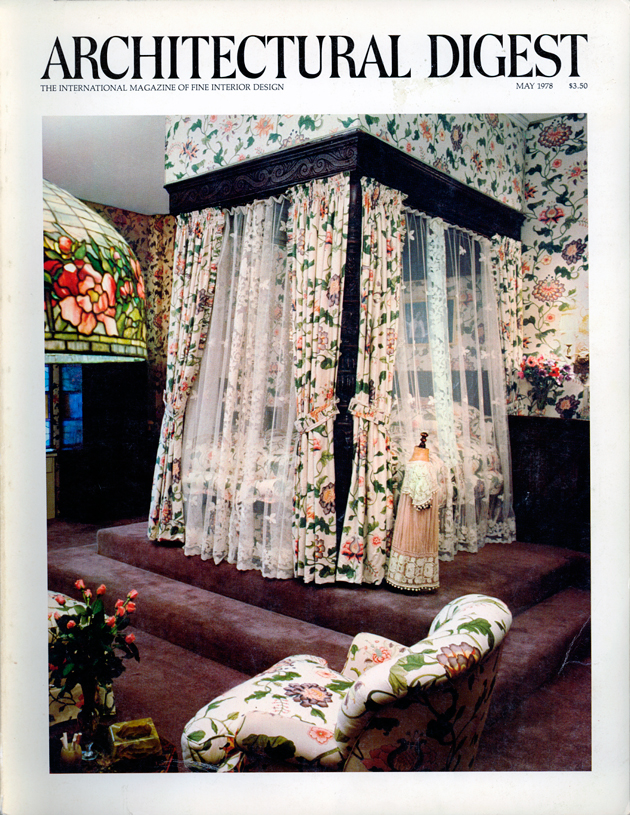
Cover: The Bedroom of Barbra Streisand's Manhattan apartment
Photographed by Richard Chapion
Text by Peter Carlsen
When Barbra Streisand told us that she has owned her Manhattan apartment for twelve years, we realized that far from being some latter-day extravagance of a superstar, this secluded duplex was the result of her first success. Indeed, the residence—with as many rooms as there are moods of this rare woman—has become a treasure house that holds memories of her career and of her taste. As she says, "I like complexity. I like to be baffled. I'm fascinated and awed by things I can't do. I think I can truly say that what I'm most interested in is having visions of things—and then making them come true. Especially when people tell me that I can't do it." See page 96.
ARCHITECTURAL DIGEST VISITS: Barbra Streisand
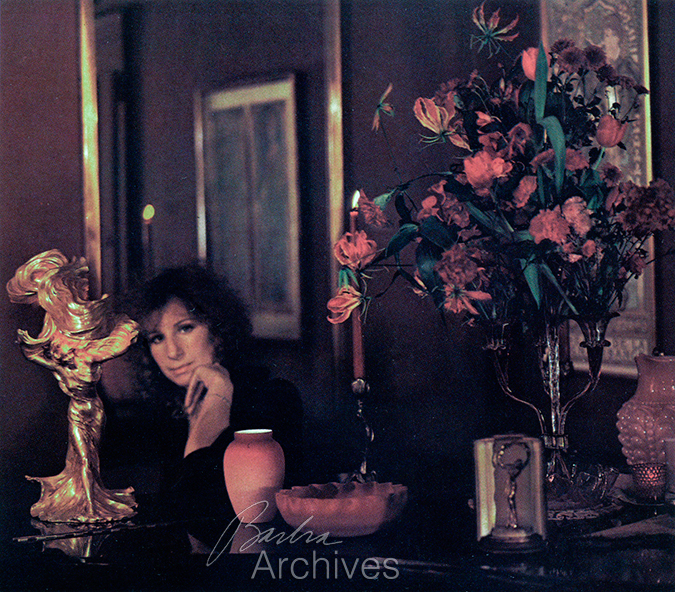
In a rare moment of repose, Barbra Streisand pauses at the piano in her nine-room Manhattan duplex overlooking Central Park. The silver figure in a case is an Art Nouveau umbrella handle.
“EVER SINCE I can remember, I've had an instinct for decoration,” says Barbra Streisand. “I can remember my first apartment in New York—it was a railroad flat on Third Avenue—and how I filled it with screens and lacquered chests. Even when I had no money, there was always the need to transform my surroundings.”
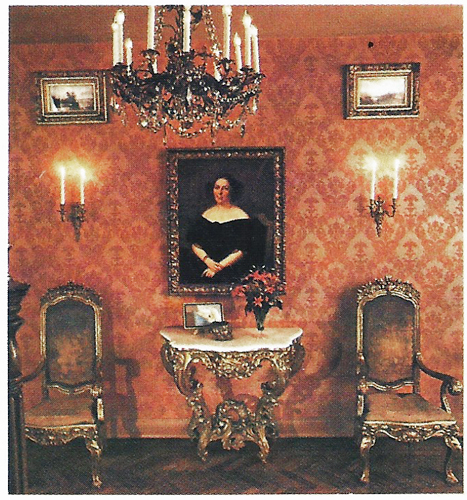
That gift for turning eccentricity into beauty, unevenness into richness and originality into fashion was a hallmark of the early Streisand years, and it still forms a vital part of her appeal. But the idiosyncratic and personal record of her New York years—and, in many ways, the fitting climax of them—is the duplex she bought twelve years ago in an eccentric and uneven part of Manhattan, the very Upper West Side. Typically, with her great sense of self-anthology, the singer has it still. The duplex has a wonderful perch in a steeply raked Art Deco building—with an exposed and windy and very fine view of Central Park. “Look, this was my first real home,” Miss Streisand explains in her urgent voice. “Let me tell you. I wanted Louis, Louis, Louis—as much as I could lay my hands on. And I got it: bronzes, porcelains, satin, moiré. Later I became far more sophisticated.”
ABOVE: The traditional balanced Entrance Hall arrangement includes a pair of Venetian chairs, a French Victorian console and an antique Italian portrait.
BELOW: Formality and soft-toned restraint characterize the Living Room, unified by the gentle shades of an Aubusson rug; glass-topped tables leave the rug's pattern undisturbed. Paintings mounted low add height to walls whose applied moldings allude to period paneling. Drapery silk, and the fabrics on sofa and open-arm chairs, are by Scalamandre.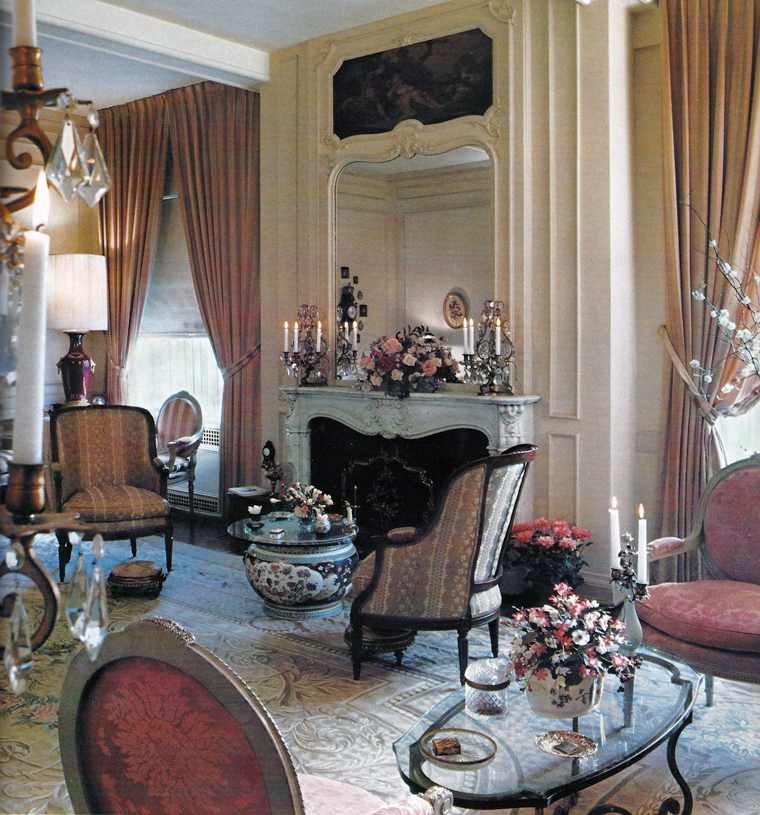
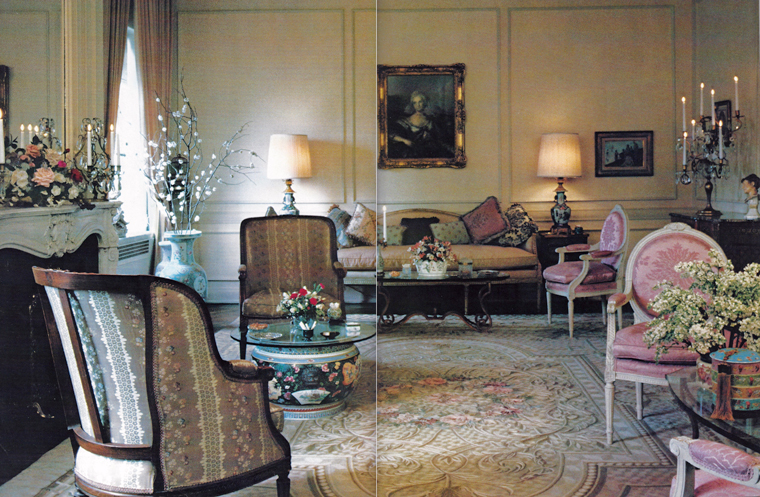
The main illustration surviving from the Streisand Rococo period is the living room. It is a remarkably restrained and delicate space, with none of the overtones of excitement and color that must have been part of its owner's life at the time she conceived it. “It's all so interesting to me now,” she says, with a possible note of irony in her voice. “I've moved so far away from this room, the politeness of it all, the conventionality. But then I guess I didn't make the connection then, the necessity of setting up a link between who you think you are and the way you live.”

(ABOVE: The French-style Dining Room is highlighted by a sumptuous tablesetting, which rests on an Irish linen cutwork cloth. The still life is Flemish.)
That came later—in rooms such as the library. “My burgundy era,” sighs Miss Streisand, “and the begining of my breakaway from the idea of dollhouse taste. I was discovering the pleasures of Victorian and Second Empire furniture, and even becoming a little daring—like covering the armchairs in a contemporary pink herringbone fabric. But even this was a beginning of the reversion to a truer self. When I made my debut at the Bon Soir at the age of eighteen, I wore a severe little Victorian blouse with a high black collar. The next day the reviews took as much notice of what I was wearing as they did of my singing. I was a little intimidated, and I didn't want anyone to think I was using my clothes as a gimmick. I suppose it was the same with this apartment. It took me a little time to be able to come out into the open and honestly say, ‘This is me, Barbra, and this is what I like.’”
The singer's taste and self-confidence continued to grow more sure, and soon she had crossed the threshold into the twentieth century. She first discovered Art Nouveau, then Art Deco, and suddenly she had come home: “All those rusts, mauves and greens, and those swooning fin-de-siècle colors and sinuous shapes! I was ecstatic, and collected what seemed like roomfuls. I still have a lot of those things in a warehouse.”
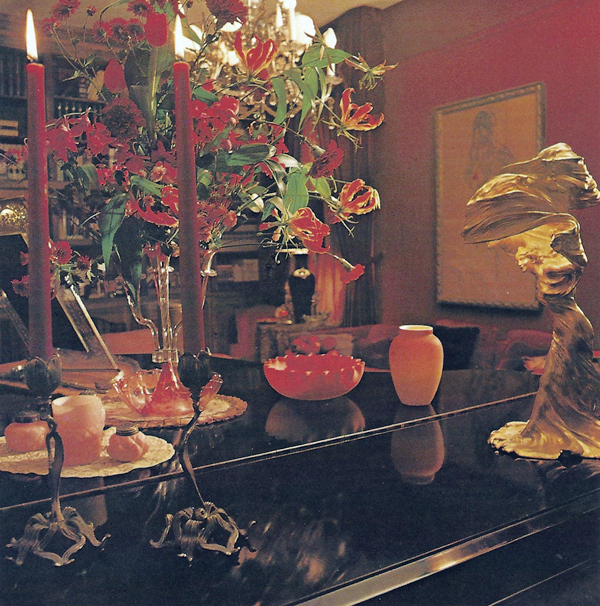
(Above: Objects on the piano in the Library represent extensive collections of Art Nouveau and Art Deco pieces: French bronze candlesticks, art glass and a bronze figure of dancer Loie Fuller.)
Barbra Streisand's interest in Art Nouveau and Art Deco is never less than intelligent, however romantic, and she is quite prepared to present a coolly delivered lecture on the precise origins and similarities between the two movements. But she is interested in many other periods and styles as well: “Chinoiserie, fine lacquers, silk embroideries—they all add another layer of complexity to my life, and it means casting my net out still further.” Already an established figure in antiques shops around the world, the star restlessly goes on adding to already almost unmanageable collections. “I've almost reached the point of saturation,” she admits, “and I'm beginning to feel a little weighed down.
“The sensibility of the 1970s is basically juxtaposition, and the cliche about mixing lace with denim is the most obvious one. But I think there are many subtleties beyond that—like living a luxurious life, surrounding yourself with wonderful objects, but still getting up in the morning and jogging and eating health foods. That sort of contrast. I think interiors should be the same. It's the shock of the unexpected that makes everything come together. Although I would add another stricture: I believe in monotones. Today, for instance, I'm all in gray. It would be dramatic to add, let us say, a scarlet belt, but I try to resist that.
“I think effects should be subtler. And this philosophy is having an effect in other areas of my life. By the way, when I mentioned clothes, I realized that I seldom think about interiors without a sort of backward glance at my wardrobe. Clothes and the environment you live in. How can you really separate them?”
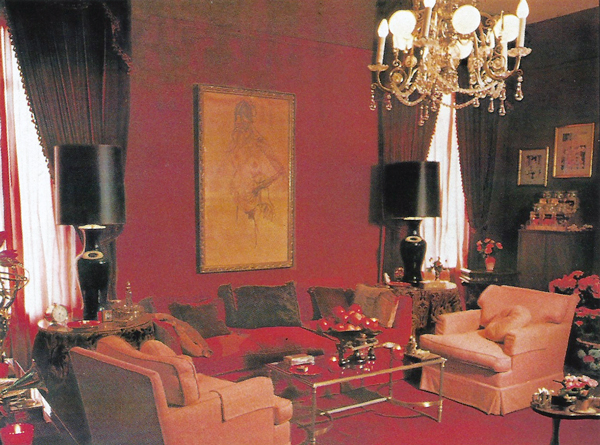
(Above: Miss Streisand refers to the library decor as her "burgundy era." That rich hue is carried out in Brunschwig & Fils velvet and herringbone tweed fabrics and a Patterson, Flynn & Martin carpet. At right, apothecary jars rest on a 1940s sheet music cabinet; at left, two Grammys and an Oscar adorn a tabletop. Painting by Jason Monet.)
Of course it is in the nature of owning things to want more—to make collections complete, to round out and fill in. And so the game continues. “Sometimes I long for a Moroccan house, all white walls and practically no furniture. Then I come to my senses. I remember how much I like burgundy, and what I feel about the future of maroon. I never deliberate about what I like. To me the act of making a choice is an emotional experience, not an intellectual one.”
As it is for any collector, the integrity of her world is important to the singer: "It drives me crazy to find that there's a leak in the ceiling, or that some of my things are moldering away in storage. I guess at heart I'm a compiler of inventories." And then Miss Streisand tells of her latest proj ect: "I would like to document everything I own—every pair of shoes, every antique fan, all my jewelry and objects. I'd like to have it all photographed and bound in volumes."
Miss Streisand might not be aware that she is emulating a stellar figure of the nineteenth century. Queen Victoria of England, who had thick albums recording all the possessions in all her palaces. Soon, indeed, Miss Streisand, with her multiplying number of California homes, may rival the late queen in terms of sheer numbers of residences.
The irony of stardom is that, while it makes certain things easy—like assembling fantastic collections—it can render simple acts extremely difficult. "My dream is just to walk along Madison Avenue and shop, without being mobbed!" says Miss Streisand in farewell. For the moment, she is happily above the crowd, above the city of New York—at home in her extraordinary private world.
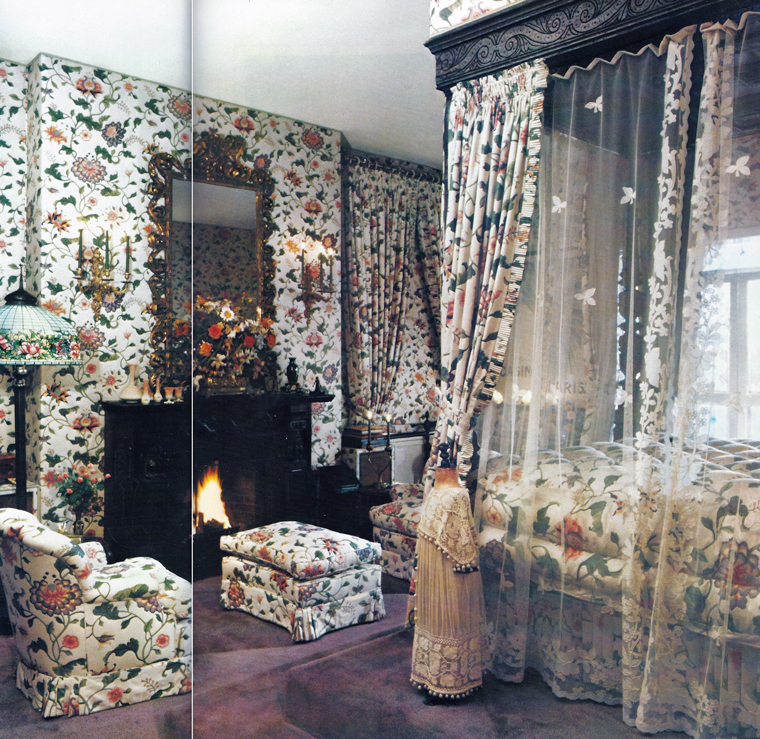
(Above: Diaphanous appliquéd bed undercurtains lend romantic delicacy to Miss Streisand's Edwardian Bedroom; a child's antique dressing gown epitomizes the feminine feeling. A platform, covered in Patterson, Flynn & Martin carpeting, visually separates sleeping and sitting areas; the unifying chintz is from Clarence House.)
End.
[ top of page ]
